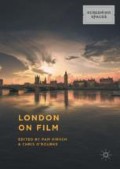Abstract
This chapter deals with several iterations of sabotage. The first dates back to 1894 when the Greenwich ‘bomb outrage’ occurred. For weeks, the press was full of reports about a twenty-six-year-old French anarchist named Martial Bourdin who died from shock and haemorrhage from the bomb he was ‘feloniously handling’ in Greenwich Park. This infamous incident was one of the key inspirations for Joseph Conrad’s 1907 novel, The Secret Agent, his only novel to be set almost entirely in London. Conrad’s novel, in turn, was loosely adapted (and updated) by Hitchcock for his 1936 film Sabotage. In his film, the threat appears to come from German fifth-columnists (rather than the Russian anarchists of the Conrad novel). Although Hitchcock always claimed in interviews to be non-political, he was unabashedly patriotic. His love for his native city is vividly apparent in his treatment of Londoners in everyday settings, in the street markets, or going to the cinema, travelling by bus, or tram or tube, and arguably these images suggest a form of social cohesion. The lingering shots of the faces of Londoners cheerfully finding their way out of the Underground by holding up matches and cigarette lighters following the power blackout in London that marks the film’s first act of sabotage represents early on in the film exactly who and what is being threatened, long before the horrific bomb outrage at the end of the film.
References
Auiler, Dan. 1999. Hitchcock’s Secret Notebooks. London: Bloomsbury.
Balcon, Michael. 1969. Michael Balcon Presents…A Lifetime of Films. London: Hutchinson.
Barr, Charles. 2009. Before Blackmail: Silent British Cinema. In The British Cinema Book, 3rd ed, ed. Robert Murphy, 145–154. London: Palgrave Macmillan.
Bennett, John Charles. 2014. Hitchcock’s Partner in Suspense: The Life of Screenwriter Charles Bennett. Kentucky: University Press of Kentucky.
Brunsdon, Charlotte. 2007. London in Cinema: The Cinematic City Since 1945. London: British Film Institute.
Durgnat, Raymond. 1974. The Strange Case of Alfred Hitchcock. London: Faber & Faber.
Giblin, Gary. 2006. Alfred Hitchcock’s London: A Reference Guide to London. USA: Midnight Marquee Press.
Glancy, Mark. 2003. The 39 Steps. London: I.B.Tauris.
———. 2007. Blackmail (1929), Hitchcock and Film Nationalism. In The New Film History: Sources, Methods and Approaches, ed. James Chapman, Mark Glancy and Sue Harper, 185–200. Basingstoke: Palgrave Macmillan.
Henderson, Robert. 2008. Vladimir Burtsev and the Russian Revolutionary Emigration: Surveillance of Foreign Political Refugees in London, 1891–1905. PhD diss., Queen Mary, University of London.
Lee, Peter W. 2014. No Laughing Matter: Imperilling Kids and Country in Alfred Hitchcock’s Sabotage (1936). In Children in the Films of Alfred Hitchcock, ed. Debbie Olson, 67–85. New York: Palgrave Macmillan.
Macintyre, Ben. 2010. Operation Mincemeat: The True Spy Story that Changed the Course of World War II. London: Bloomsbury.
McGilligan, Patrick. 2003. Alfred Hitchcock: A Life in Darkness and Light. New York: HarperCollins.
Miller, Henry K. 2016. Papa du Cinema. Sight and Sound 26 (3): 36–41.
O’Brien, Scott. 2016. Sylvia Sidney: Paid by the Tear. Albany: BearManor Media.
Richards, Jeffrey, and James C. Robertson. 2009. British Film Censorship. In The British Cinema Book, 3rd ed, ed. Robert Murphy, 67–77. London: Palgrave Macmillan.
Russell Taylor, John. 1996. Hitch: The Life and Times of Alfred Hitchcock. New York: De Capo Press.
Ryall, Tom. 1996. Alfred Hitchcock and the British Cinema. London: Athlone.
Sabotage: Full Treatment, May 14, 1936. British Film Institute (BFI) Special Collections, S 230 and 231.
Sabotage (Scenario) submitted by Gaumont British Picture Corporation. BFI Special Collections, S230 and 231.
Sargeant, Amy. 2005. British Cinema: A Critical History. London: British Film Institute.
Smith, Susan. 2000. Hitchcock: Suspense, Humour and Tone. London: British Film Institute/Palgrave Macmillan.
Spoto, Donald. 1999. The Dark Side of Genius: The Life of Alfred Hitchcock. New York: De Capo Press.
The Illustrated Police Budget. 1894. February 24.
Truffaut, Francois. 1984. Hitchcock, Rev. ed. New York: Simon & Schuster.
Yacowar, Maurice. 2010. Hitchcock’s British Films. Detroit: Wayne State University Press.
Author information
Authors and Affiliations
Corresponding author
Editor information
Editors and Affiliations
Rights and permissions
Copyright information
© 2017 The Author(s)
About this chapter
Cite this chapter
Hirsch, P. (2017). Hitchcock’s Sabotage (1936): Conspirators and Bombs in Actual, Literary and Filmic London. In: Hirsch, P., O'Rourke, C. (eds) London on Film. Screening Spaces. Palgrave Macmillan, Cham. https://doi.org/10.1007/978-3-319-64979-5_4
Download citation
DOI: https://doi.org/10.1007/978-3-319-64979-5_4
Published:
Publisher Name: Palgrave Macmillan, Cham
Print ISBN: 978-3-319-64978-8
Online ISBN: 978-3-319-64979-5
eBook Packages: Literature, Cultural and Media StudiesLiterature, Cultural and Media Studies (R0)

